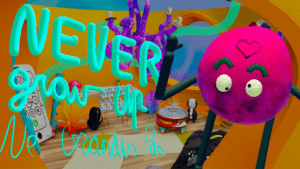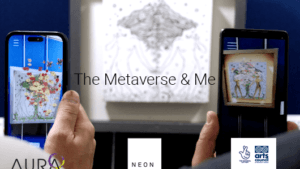
FIVARS Fall 2022 Spotlight: Interview with Cosmic•Atomic director Christopher Boulton
Cosmic•Atomic is an immersive trip across time and space and a nostalgic love letter to the past in pursuit of a more #OpenScience future. While it had its debut at FIVARS in FEB 2022, it has returned with a vengeance, having done a tour of the world and at a higher resolution than before.
FIVARS had a chance to speak with director Christopher Boulton.
What lead to the creation of this piece?
 Cosmic•Atomic was a long time in the making. It began in 2017 as Pop Science Cinema, a presentation at the Society for Cinema and Media Studies conference in Chicago, where I analyzed Powers of Ten as it played behind me in real-time. And then, similar to how Charles and Ray Eames took nine years to refine their black and white “Rough Sketch” into the full-color Powers of Ten, I adapted my scholarly presentation into a more evocative mode by removing the voice-over and synchronizing the Eames’ source material and remakes. I even animated still images from the Boeke book that started it all. I called this version Power Trip and released it as a short film in 2019.
Cosmic•Atomic was a long time in the making. It began in 2017 as Pop Science Cinema, a presentation at the Society for Cinema and Media Studies conference in Chicago, where I analyzed Powers of Ten as it played behind me in real-time. And then, similar to how Charles and Ray Eames took nine years to refine their black and white “Rough Sketch” into the full-color Powers of Ten, I adapted my scholarly presentation into a more evocative mode by removing the voice-over and synchronizing the Eames’ source material and remakes. I even animated still images from the Boeke book that started it all. I called this version Power Trip and released it as a short film in 2019.
Two years later, I began adapting the film for VR in the hopes that the new technology could help recapture the initial awe and wonder people felt when they saw Powers of Ten for the first time. My original concept was to use the six sources to create a virtual box inside of a VR headset, like a camera obscura, so the viewer would feel the walls, floor, and ceiling pulling away all around them. But, when I tried it, the result felt claustrophobic. The screens were too close.
So, in order to push them back to a more comfortable viewing distance, I developed a ring concept and doubled the screens so each had its mirror opposite at 180 degrees. So, in a way, Cosmic•Atomic is a remake of a remake of many remakes. It’s also my attempt to celebrate the scientific method in the face of rising anti-intellectual or “post-truth” populism in the United States and around the world.

What was the production process for you and your team? What did you learn?
One of the biggest challenges that arose when adapting Power Trip for VR was the resolution of the source material. Much of the archival footage was standard definition, so we had to upscale it to today’s standards in order to ensure that critical details could be still seen. We used AI Video Enhance by Topaz Labs to convert the footage into the resolution we wanted by way of artificial intelligence without degrading the quality.
I’m particularly happy with how the AE exponential zoom animation of the illustrations from Kees Boeke’s book help put it on equal footing with his many time-based imitators. Due to the nature of the project, the editing and mixing in Adobe Premiere was fairly straightforward, though, suffice it to say, juggling and synching 12 screens was an extended and tedious process.
We showed an earlier version of this project at FIVARS in FEB and got some really helpful feedback from Keram et al. One of the major revisions we made for Fall was the inclusion of a higher rez (16K Cylindrical VR Master) version of the Adler Planetarium for the European Southern Observatory’s “Blueprints of the Universe.”
This has made Cosmic•Atomic’s zenith so much sharper and more impactful than what we had before and has gotten a great response on the festival circuit, winning Best VR Interactive Documentary at the Melbourne Documentary Film Festival and both the jury and audience awards for Best Immersive at CineGlobe in Geneva.
It was also a VR Storytelling Award Finalist at the LICHTER Filmfest in Frankfurt and has been selected by over fifteen other festivals across four continents including Byron Bay (Australia), Florida (USA), Guanajuato (MX), Thessaloniki (Greece), and VRE (Italy).
How did you become an immersive media content creator and why?
I was invited by a colleague to try it out and jumped at the chance to challenge my thinking by extending my work to a new dimension.
What is the VR/AR industry like in your region?
I’m so new that I’d be hesitant to say. But it’s great to see fellow professor Malia Bruker’s work Threshold here at FIVARS since we both screened at the University Film and Video Association (UFVA) Conference, which has a New Media Caucus that supports VR/XR work and honored Threshold with its first prize award.
What do you have planned for the future?
I’ll be returning to 2D filmmaking in the near future, working to develop co-creative/non-extractive documentary production processes with my students…but will certainly keep my eye open for more 3D/360/immersive opportunities/inspirations in the future.
What would you like to share with fellow content creators and/or the industry?
Just my appreciation to those who have been working so hard to break new ground and blaze trails for people like me to admire, follow, and explore.
Do you think VR festivals like FIVARS are important?
Absolutely. FIVARS pushes tech-forward while maximizing access through inclusive platform flexibility and creates aesthetic equity by embracing a wide and diverse range of avant-garde immersive and augmented artworks while taking care to create community amongst the artists that make them.
Learn more about Cosmic•Atomic at FIVARS in FALL 2022
Check out this special 3-minute making-of video with Dr. Boulton!:












